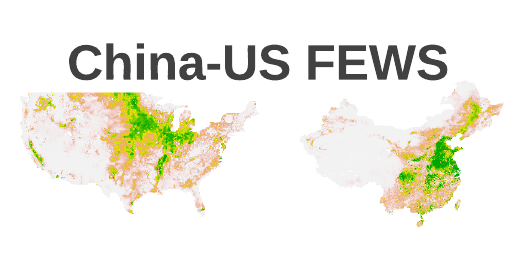Overview
As global population rises to 7.5 billion people and beyond, concern is growing about the planet's carrying capacity across the multiple and interacting dimensions of food, water and energy systems (FEWS). The overarching goal of this project is to enable the transition to sustainable FEWS by achieving the multi-factorial assessment of tradeoffs needed to achieve sustainability. The approach proposed here extend and adapt to China a framework developed by this team for the U.S. As two of the largest countries by many metrics: population, land mass, agricultural production, GDP China and the U.S. will have an extraordinary role in transitioning from today's largely unsustainable practices. This project builds a China-U.S. collaboration framed as a Virtual Research Center (FEWS-VRC) between 3 Chinese academic institutions (Center for Energy and Environmental Policy Research, State Key Laboratory of Hydrology-Water Resources and Hydraulic Engineering, and Center for Chinese Agricultural Policy) and Purdue University. FEWS-VRC will push the frontier of quantitative systems sustainability analysis in two directions: 1) assessing the role of heterogeneity by extending the use of gridded modeling of agricultural production coupled with land-water use; and 2) analysis of interactions between agriculture and new sources of energy, particularly bio-based energy. The tools developed here will be built on a Science Gateway platform (FEWS-HUB) that will provide a quantitative, extensible basis for solving crucial future research and planning problems thus improving decision-making capabilities in FEWS topics within the world's two largest economies.:
The first objective of the FEW-VRC is to jointly develop a Chinese version of the Purdue-developed SIMPLE-G-US model that is already being applied to the U.S. Building on early successes with the U.S., this project will begin with the development of a baseline scenario for China complemented with several policy scenarios to assess the tradeoffs in the transition to a more sustainable economy, including: greater protection of land and water resources, reversing land degradation, less intense use of agricultural chemicals and fertilizers. Though standard practice for integrated assessment, this project will add to the existing knowledge in several dimensions: gridded modeling of agricultural production; and coupling of the gridded agricultural model to a detailed general equilibrium model. Spatial models at a national level are too coarse to deal with the heterogeneity of agricultural production. Moreover, as water is ever more becoming a constraining factor for agriculture, it is vital to link agricultural production and hydrological models at basin scale. An expected outcome of this study is a framework to assess the importance of gridded-level heterogeneity as well as potential 'hotspots' linked to water availability. A second goal is coupling the Purdue-developed ENVISAGE Model to SIMPLE-G thus extending the latter model to include energy systems. ENVISAGE is an integrated assessment model with a large energy sub-module that provides an assessment of changes in bio-based energy including land-use implications. Coupling these two disparate models will allow new research questions to be addressed in a tractable and traceable framework. The project will benefit significantly from the trans-Pacific collaboration particularly as a data source for SIMPLE-G-China and to improve the energy module of ENVISAGE. :
GLASS personnel
Matt Huber, Dominique van der Mensbrugghe, Jing Liu, Tom Hertel and Carol Song.
